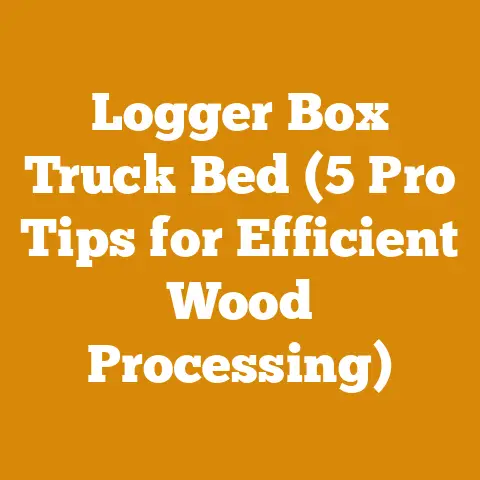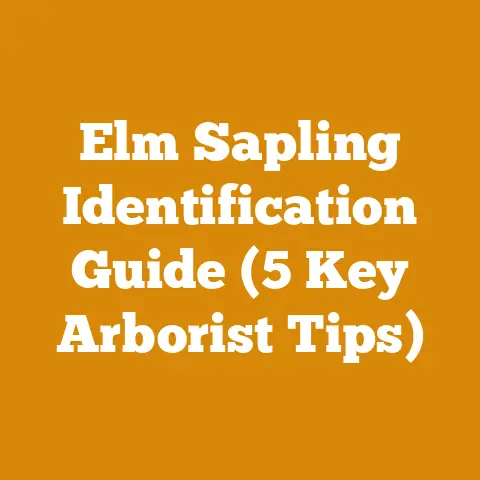Triclopyr 3 vs 4 for Buckthorn Control (5 Expert Tips)
Let’s bust a myth right off the bat.
Many folks assume that herbicide choice for buckthorn control is a simple matter of picking the “strongest” option.
That’s like saying any old hammer will do for intricate woodworking – it just ain’t so!
The truth is, effective buckthorn control hinges on understanding the nuances of different herbicide formulations, how they interact with the plant, and the specific environmental conditions you’re working with.
Triclopyr 3 and Triclopyr 4 are both potent tools, but using them interchangeably or without proper knowledge is a recipe for disappointment, or worse, environmental damage.
Buckthorn Control: Triclopyr 3 vs 4 (5 Expert Tips)
Globally, invasive species management is a multi-billion-dollar industry.
Buckthorn, in particular, is a major headache in North America and increasingly in parts of Europe and Asia.
Its aggressive growth chokes out native vegetation, reduces biodiversity, and alters soil composition.
The problem is significant: studies show that buckthorn infestations can reduce native plant species richness by up to 75% in affected areas.
That’s a staggering loss of biodiversity.
The firewood industry also feels the sting.
Buckthorn isn’t worth burning and its presence on managed lands reduces the yield of more desirable species like oak or maple.
I’ve spent countless hours battling buckthorn on my own property and consulting with landowners and forestry professionals.
From my experience, success isn’t about brute force; it’s about strategic application, understanding the herbicide’s properties, and adapting to the specific challenges of each site.
Think of it like choosing the right saw for the job – a chainsaw is great for felling trees, but a coping saw is essential for fine detail work.
Similarly, Triclopyr 3 and Triclopyr 4 each have their strengths and weaknesses in the fight against buckthorn.
Let’s delve into the specifics and equip you with the knowledge to make informed decisions.
Understanding the Players: Triclopyr 3 and Triclopyr 4 Explained
Before we dive into the tips, let’s clarify what we’re dealing with.
Triclopyr is a selective systemic herbicide, meaning it’s designed to kill certain plants (broadleaf weeds) while leaving others relatively unharmed (grasses).
It works by disrupting plant growth hormones, ultimately leading to the plant’s demise.
The “3” and “4” refer to the concentration of triclopyr in the formulation, often expressed as pounds of active ingredient per gallon.
- Triclopyr 3: This formulation typically contains 3 pounds of triclopyr per gallon.
It’s often formulated as an amine salt, which is water-soluble and readily translocated within the plant.
Products like Garlon 3A are common examples. - Triclopyr 4: This formulation contains 4 pounds of triclopyr per gallon.
It’s often formulated as an ester, which is oil-soluble and can penetrate the waxy cuticle of leaves more effectively.
Products like Garlon 4 Ultra are common examples.
The key difference lies in their formulation (amine vs.
ester) and concentration.
This impacts their effectiveness, application methods, and environmental considerations.
It’s like the difference between a splitting axe and a maul.
Both split wood, but one is designed for smaller rounds and the other for larger, gnarlier pieces.
5 Expert Tips for Buckthorn Control with Triclopyr
Now, let’s get down to brass tacks.
Here are five expert tips, gleaned from years of experience, to help you effectively control buckthorn using Triclopyr 3 and Triclopyr 4.
Tip 1: Choose the Right Formulation for the Application Method
This is where many folks stumble.
You can’t just grab any bottle and expect stellar results.
The application method dictates the best formulation.
- Cut-Stump Treatment: This involves cutting the buckthorn stem close to the ground and immediately applying herbicide to the freshly cut surface.
This method is highly effective, as it delivers the herbicide directly to the plant’s vascular system.
For cut-stump treatment, Triclopyr 4 (ester formulation) is generally preferred.
The oil-soluble nature of the ester allows it to penetrate the bark and cambium layer more effectively, even in cold weather.
I’ve seen cut-stump treatments with Triclopyr 4 remain effective even when applied on a day with light frost.- Data Point: Studies show that cut-stump treatments with Triclopyr 4 can achieve over 90% control of buckthorn in a single application when applied correctly.
- Actionable Step: Mix Triclopyr 4 with a suitable oil-based carrier (e.g., basal oil) according to the product label.
Apply liberally to the entire cut surface, including the bark.
A small paintbrush, sponge applicator, or low-pressure sprayer works well.
- Foliar Spray: This involves spraying the herbicide directly onto the leaves of the buckthorn plant.
This method is best suited for smaller infestations or when targeting specific plants within a larger area.
For foliar applications, Triclopyr 3 (amine formulation) is usually the better choice.
The water-soluble nature of the amine allows it to be readily absorbed by the leaves and translocated throughout the plant.- Data Point: Foliar applications of Triclopyr 3 are most effective when applied during the growing season when the buckthorn is actively photosynthesizing.
- Actionable Step: Mix Triclopyr 3 with water and a surfactant (to help the herbicide stick to the leaves) according to the product label.
Spray the foliage thoroughly, ensuring complete coverage.
Avoid spraying on windy days or when rain is expected.
Tip 2: Timing is Everything: Hitting Buckthorn at Its Weakest Point
Just like knowing when to fell a tree for optimal drying (late fall or winter, after the sap has receded), timing your herbicide application is crucial.
- Cut-Stump Treatment Timing: Late fall or winter (after the leaves have fallen) is often the best time for cut-stump treatments.
The buckthorn is dormant, and the herbicide is less likely to be taken up by non-target plants.
However, it’s important to apply when the ground is not frozen. - Foliar Spray Timing: Late summer or early fall is often the sweet spot for foliar applications.
The buckthorn is still actively growing but is also preparing to go dormant, which means it’s actively transporting nutrients (and herbicide) to its roots.
Avoid spraying during flowering, as you could harm beneficial insects.- Personal Story: I once made the mistake of spraying buckthorn in the spring, right as it was leafing out.
The herbicide seemed to work initially, but the plants quickly recovered.
Turns out, the buckthorn was putting all its energy into new growth, and the herbicide couldn’t effectively reach the root system.
- Personal Story: I once made the mistake of spraying buckthorn in the spring, right as it was leafing out.
Tip 3: The Power of Surfactants and Penetrants
Think of surfactants and penetrants as the “secret sauce” that boosts the effectiveness of your herbicide application.
- Surfactants: These reduce the surface tension of the spray solution, allowing it to spread more evenly over the leaves.
This ensures better coverage and absorption of the herbicide. - Penetrants: These help the herbicide penetrate the waxy cuticle of the leaves, especially important for buckthorn, which has a thick, waxy coating.
Always check the herbicide label for specific recommendations on surfactants and penetrants.
Some products already contain a surfactant, while others require you to add one separately.
I’ve found that adding a non-ionic surfactant to my Triclopyr 3 foliar sprays significantly improves their effectiveness, especially on mature buckthorn plants with thick, waxy leaves.
It’s akin to using a sharp chain on your chainsaw, everything just works more efficiently.
Tip 4: Calibrating Your Sprayer: Precision is Key
Over-application of herbicide is wasteful, expensive, and can harm the environment.
Under-application can lead to ineffective control and require repeat treatments.
Calibrating your sprayer ensures you’re applying the correct amount of herbicide.
- Step 1: Determine your walking speed. Measure a known distance (e.g., 50 feet) and time how long it takes you to walk that distance at a steady pace.
- Step 2: Determine your sprayer output. Fill your sprayer with water and spray into a container for a set amount of time (e.g., 1 minute).
Measure the amount of water collected. - Step 3: Calculate your application rate. Use the information from steps 1 and 2 to calculate how much spray solution you’re applying per unit area (e.g., gallons per acre).
- Step 4: Adjust your sprayer as needed. Adjust the nozzle, pressure, or walking speed to achieve the desired application rate.
There are numerous online resources and calculators to help you with sprayer calibration.
Taking the time to calibrate your sprayer is an investment that will pay off in the long run.
Tip 5: Integrated Pest Management: A Holistic Approach
Herbicide application is just one tool in the toolbox.
A truly effective buckthorn control strategy involves an integrated pest management (IPM) approach.
This means combining different methods to achieve long-term control while minimizing environmental impact.
- Mechanical Removal: Hand-pulling small seedlings or using a weed wrench to remove larger plants can be effective, especially for small infestations.
This is labor-intensive but avoids the use of herbicides. - Prescribed Burning: Burning can kill buckthorn seedlings and top-kill mature plants.
This is most effective in fire-adapted ecosystems. - Re-vegetation: Planting native trees, shrubs, and grasses can help outcompete buckthorn and prevent re-infestation.
- Monitoring: Regularly monitor treated areas for new buckthorn growth and take action as needed.
Remember, buckthorn control is a marathon, not a sprint.
Consistent effort and a holistic approach are essential for long-term success.
The Nitty-Gritty: Safety, Costs, and Resource Management
Let’s not forget the practical aspects of buckthorn control.
Safety First: Always wear appropriate personal protective equipment (PPE) when handling herbicides, including gloves, eye protection, long sleeves, and pants.
Read and follow the herbicide label carefully.
Store herbicides in a secure location, away from children and pets.
Cost Considerations: The cost of buckthorn control can vary depending on the size of the infestation, the methods used, and the cost of labor and materials.
Herbicides can range from \$50 to \$200 per gallon, depending on the formulation and concentration.
Mechanical removal can be labor-intensive and may require specialized equipment.
Resource Management: Plan your buckthorn control project carefully to minimize waste and maximize efficiency.
Use only the amount of herbicide needed.
Consider using a backpack sprayer or other targeted application method to minimize off-target spray.
Dispose of empty herbicide containers properly.
Troubleshooting: Common Pitfalls and How to Avoid Them
Even with the best planning, things can go wrong.
Here are some common pitfalls to avoid:
- Incomplete Coverage: Make sure to thoroughly cover the leaves or cut surface with herbicide.
Missed spots will allow the buckthorn to regrow. - Application During Unfavorable Weather: Avoid spraying on windy days or when rain is expected.
Wind can cause the herbicide to drift onto non-target plants, and rain can wash it away before it has a chance to be absorbed. - Using the Wrong Herbicide: As we’ve discussed, Triclopyr 3 and Triclopyr 4 are not interchangeable.
Choose the right formulation for the application method. - Ignoring Follow-Up Treatments: Buckthorn is persistent.
Regular monitoring and follow-up treatments are essential for long-term control.
Next Steps and Additional Resources
Now that you’re armed with the knowledge to tackle buckthorn, here are some next steps:
- Identify the buckthorn species: Knowing whether you’re dealing with common buckthorn ( Rhamnus cathartica) or glossy buckthorn (Frangula alnus) can influence your control strategy.
- Assess the extent of the infestation: Determine the size and density of the buckthorn infestation to help you plan your control efforts.
- Develop an IPM plan: Combine different control methods to achieve long-term success.
- Consult with a professional: If you’re unsure about any aspect of buckthorn control, consult with a certified arborist, forester, or other qualified professional.
Here are some additional resources that may be helpful:
- Your local extension office: Extension offices offer a wealth of information on invasive species management, including buckthorn control.
- State and federal agencies: State departments of natural resources and the U.S.
Forest Service provide information and resources on invasive species management. - Invasive species organizations: Organizations like the Midwest Invasive Plant Network (MIPN) and the Nature Conservancy offer information and resources on invasive species management.
Battling buckthorn is a challenging but rewarding endeavor.
By understanding the nuances of Triclopyr 3 and Triclopyr 4, employing strategic application methods, and adopting an integrated pest management approach, you can effectively control buckthorn and restore the health of your land.
It is no different than selecting the right wood for the job, or using the right tools for the job.
Remember, persistence and a well-thought-out plan are key to success.
Now, get out there and give those buckthorn bullies a taste of their own medicine!






